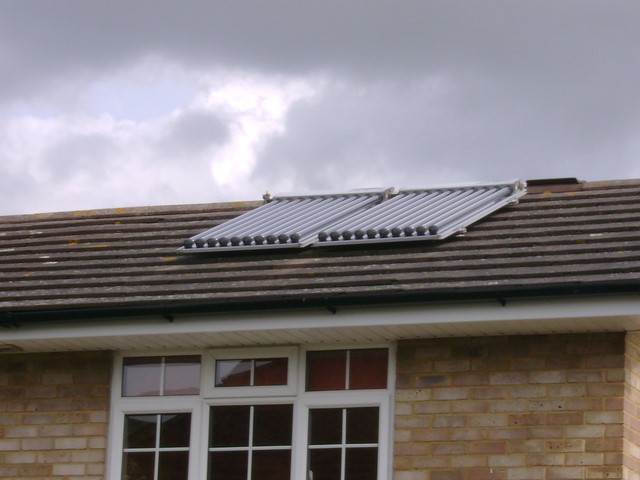Solar thermal is a popular choice for many householders, mainly because of the relatively low capital cost and the ability of the system to benefit a wide range of houses. Unlike solar photovoltaics, solar thermal does not produce electricity. The panels are designed to warm water which, depending on the set up, can be used to supply hot water to the home or even to heat water for swimming pools or small central heating systems.
 London Permaculture / CC BY-NC-SA 2.0
London Permaculture / CC BY-NC-SA 2.0
Solar thermal systems use the heat from the sun to warm a special heat transfer fluid inside the collector plates. This fluid is either passed through a heat exchanger in a hot water storage tank where it warms the water inside or in some cases is returned to the cylinder directly, and then returns to the plates to be heated again. Solar thermal is suitable for most homes that have a south or southeast / southwest facing roof space, and require a lot less space than photovoltaics; usually around 1m2 compared to 3m2 for PV.
Parts of a solar thermal system
In a typical domestic solar system, there will be three main parts:
- A solar collector: The visible panel that is placed on top of the roof to capture the heat from the sun.
- A pump: To move the heat transfer fluid around the system. Some systems use natural convection to achieve this, in a process known as ‘thermosyphoning’, but the majority use an electric pump.
- A hot water tank: Hot water tanks for solar thermal systems tend to be larger than the average hot water tank. Many homes will have a backup electric immersion or even a boiler system to heat the water to the required temperature when the heat from the sun is not adequate, so they may need to have two or even three inlets for heat exchangers, as well as an outlet to return heat transfer fluid to the solar collector.
Types of system
The two main types of system are:
- Open loop: This system passes water from the tank directly through the solar panel where it is heated and then returned to the tank. These types of systems are generally cheaper to install, but come with the potential problem of pipes freezing in the winter, and a lower general heat transfer efficiency.
- Closed loop: This system uses a fluid similar to antifreeze to transfer heat from the solar collector to the water in the tank. Because this requires a special type of tank containing a heat exchanger, this system is more expensive to install, but thanks to the properties of the transfer fluids use, allows for a much higher heat generation to occur.
Types of solar collectors
Solar thermal panels are very simple in their operation, and in fact it has been known for people to create basic solar collectors from old radiators painted black. However, when it comes to creating enough heat to make them a viable addition to a domestic home, a little more thought needs to be put into the design and selection of the panels. The two main options you will have are flat plate or evacuated tube.
- Flat plate collectors: Usually the cheaper option, flat plate collectors have a black or very dark coloured chrome surface absorber, which is usually protected with safety glass. This allows efficient absorption of heat and minimal heat losses. Running through the absorber are a series of flow tubes containing either water or antifreeze, which pass through the collector in loops to maximise heat transfer. Underneath this is a layer of insulation, which minimises heat losses from the panel and protects the roof underneath.
- Evacuated tube collectors: These types of collectors are made up of a series of vacuum tubes, each of which is made from glass. Inside they have an inner tube, coated with a material to maximise the heat absorption. Inside this is a pipe which circulates the heat transfer fluid around the panel.
Deciding which collector to purchase will depend on your budget more than anything else. Evacuated tube collectors have excellent insulation properties, allowing temperatures inside to reach up to 180 degrees Celsius whilst still remaining cool to the touch. This means they still perform well in cold weather, unlike flat plate collectors which suffer due to heat loss. More sunlight is captured by evacuated tube collectors too, as the higher surface area lets them remain exposed to the sun all through the day. If your budget will stretch to it, evacuated tubes are an all-round better system, but typically cost from £1,000 to £3,000 more than flat plate collectors.
What savings can you expect?
Solar thermal systems can provide up to 60% of a households hot water requirements and need very little maintenance. In terms of cost savings, reported savings range from £40 per annum up to £100, depending on the fuel they are replacing, the size of the system and the tariff the household is on. Households cannot yet apply to the Renewable Heat Incentive (RHI). The RHI is expected to be in place by the spring of 2013 and the government has stated it intends to make owners of qualifying renewable heating systems installed between 15th July 2009 and the launch of the scheme eligible for the RHI. Solar thermal is expected to attract a payment of 19.2p per kWh of heat generated. In the meantime, households can apply to the Renewable Heat Premium Payment scheme (RHPP) which grants £600 towards the initial cost of a solar thermal system. The Green Deal scheme can also provide an affordable way to install a solar system right now, with repayments being made via energy bills.


